Why Kit Dissection Remains Essential for Hands-On Learning
Kit dissection is the process of using specialized tools and preserved specimens to explore the internal structures of organisms for educational purposes. Whether you're teaching middle school biology or advanced anatomy, the right dissection kit can transform abstract concepts into tangible learning experiences.
Quick Kit Dissection Overview:
- Basic Tools: Scalpel, forceps, scissors, teasing needles, dissection pins
- Common Specimens: Frogs, perch, earthworms, flowers, owl pellets
- Time Required: 30 minutes to 2 hours depending on specimen
- Age Range: 11+ for most kits, with supervision required
- Cost: $13.95 for basic 9-piece sets to $50+ for advanced kits
Since 1994, educational suppliers have provided thousands of dissection kits to schools across America. These kits offer students direct access to anatomical structures that textbook diagrams simply can't match. The tactile experience of identifying a frog's heart chambers or tracing a flower's reproductive parts creates lasting memories and deeper understanding.
Modern dissection kits solve many traditional problems. Specimens now come vacuum-packed, odorless, and preserved without harsh chemicals. Tools are made from durable stainless steel and organized in portable cases. Even disposal has become simpler - used specimens can be stored in sealed bags without additional preservatives.
But choosing the right kit isn't straightforward. Age-appropriate tools, specimen types, safety requirements, and budget constraints all factor into the decision. Some schools are moving toward virtual alternatives, while others double down on hands-on experiences.
I'm Mortuary Cooler, and I've spent years helping educational institutions select durable lab equipment that meets their specific needs. Through my work with American Mortuary Coolers, I've seen how proper kit dissection tools can improve learning outcomes while maintaining safety standards.
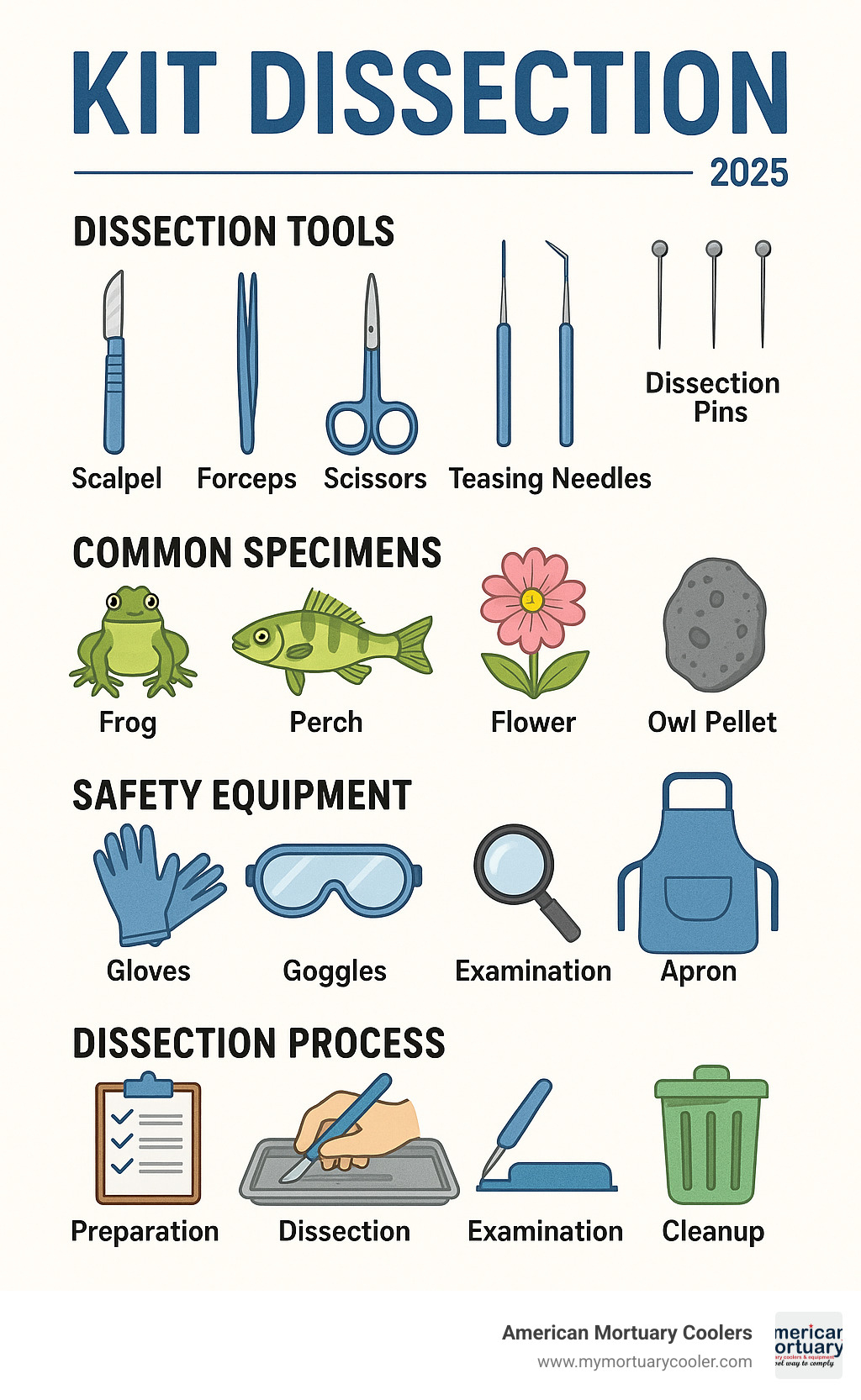
Dissection Kits 101: Components, Specimens, and Learning Outcomes
When you first open a kit dissection set, you're not just looking at tools and specimens – you're holding the keys to understanding life itself. These carefully designed educational packages transform abstract biology concepts into real, touchable experiences that stick with students long after class ends.
The magic happens when students move beyond textbook diagrams to actually feel the texture of a frog's skin or trace the delicate veins in a flower petal. This tactile learning approach develops scientific skills and critical thinking in ways that screens simply can't match. Students learn to observe carefully, make hypotheses, and draw conclusions based on what they find with their own hands.
What Is Inside a Standard Dissection Kit?
Every quality dissection kit starts with precision instruments made from durable stainless steel. The heart of any kit is the cutting tools. Scalpels with interchangeable handles and disposable surgical blades give you the precision needed for clean cuts. Scissors come in different varieties – some with sharp points for detailed work, others with blunt ends for safer handling.
For grasping and manipulating tissues, forceps are essential. Standard forceps with serrated tips provide secure gripping, while specialized tissue forceps minimize damage to delicate structures. Teasing needles separate tissues and probe small spaces. Pins secure your specimens to the plastic tray, keeping everything in place while you work.
Everything comes organized in a storage case – usually a black plastic roll or portfolio that keeps your tools safe and ready for the next lab session. Advanced kits often feature dye-injected specimens where arteries appear red and veins blue, making it much easier to trace circulatory systems.
Specimens You Can Explore
Earthworms serve as perfect introductions to dissection. Their segmented bodies clearly show how organs repeat and connect, making them ideal for younger students. Preserved frogs remain the gold standard for many biology classes, providing about two hours of hands-on exploration suitable for students age 11 and up.
Perch open up fish anatomy. Their gills demonstrate how aquatic animals extract oxygen from water. Fetal pigs represent the most advanced mammalian specimens, offering detailed looks at organs that closely resemble human anatomy.
Flower dissections, especially lily specimens, reveal the intricate world of plant reproduction. Owl pellets offer something completely different – these compressed masses tell stories about predator-prey relationships and food webs.
How to Choose the Perfect Kit Dissection for Your Learning Goals
Choosing the right kit dissection can feel overwhelming with so many options available. Your budget sets the foundation for everything else. Basic dissecting instrument kits start around $21.77 and work beautifully for middle school or high school students. If you're teaching college-level courses, consider investing in 23-piece kits priced between $35-50.
Age group considerations go beyond just the tools themselves. Younger students need simpler specimens and more supervision, while older students can handle complex dissections independently. The preservation method also matters – modern vacuum-packed specimens are odorless and nontoxic, making classroom management much smoother.
Matching a Kit Dissection to Age and Curriculum
Elementary students (ages 8-11) do best starting with plant dissections and owl pellets. Flower dissections take about 30 minutes and cost roughly $0.30 per lily – perfect for budget-conscious classrooms.
Middle school students (ages 11-14) are ready for basic dissecting instrument kits and simple animal specimens. Earthworms and crayfish provide excellent introductions to organ systems. Frog dissection becomes appropriate at age 11 with proper supervision.
High school students (ages 14-18) benefit from advanced 23-piece kits that support detailed anatomical study. Perch dissections with accompanying worksheets teach vertebrate anatomy effectively, while fetal pig specimens offer comprehensive exploration of mammalian organ systems.
College-level work demands professional-grade instruments and complex specimens. Human brain dissections require specialized tools and extensive safety protocols.
For educators interested in forensic applications, you might find value in exploring more information about forensic pathology services to understand how dissection skills apply in professional settings.
Physical vs. Virtual Kit Dissection: Pros and Cons
Physical dissection offers something screens simply can't replicate – tactile feedback that develops spatial reasoning skills. When students feel the difference between muscle and connective tissue, they're building understanding that lasts. The authentic scientific methodology also matters since real researchers don't work with computer simulations exclusively.
However, physical kits come with challenges. Ongoing specimen costs add up quickly, storage requires proper refrigeration, and disposal must follow safety protocols. Some students have ethical concerns about animal specimens.
Virtual alternatives solve many practical problems. One-time software costs replace ongoing specimen expenses, there's no storage or disposal concerns, and students with allergies can participate fully.
But virtual tools miss that crucial hands-on component. Screen-based learning doesn't develop the manual dexterity that future medical professionals need.
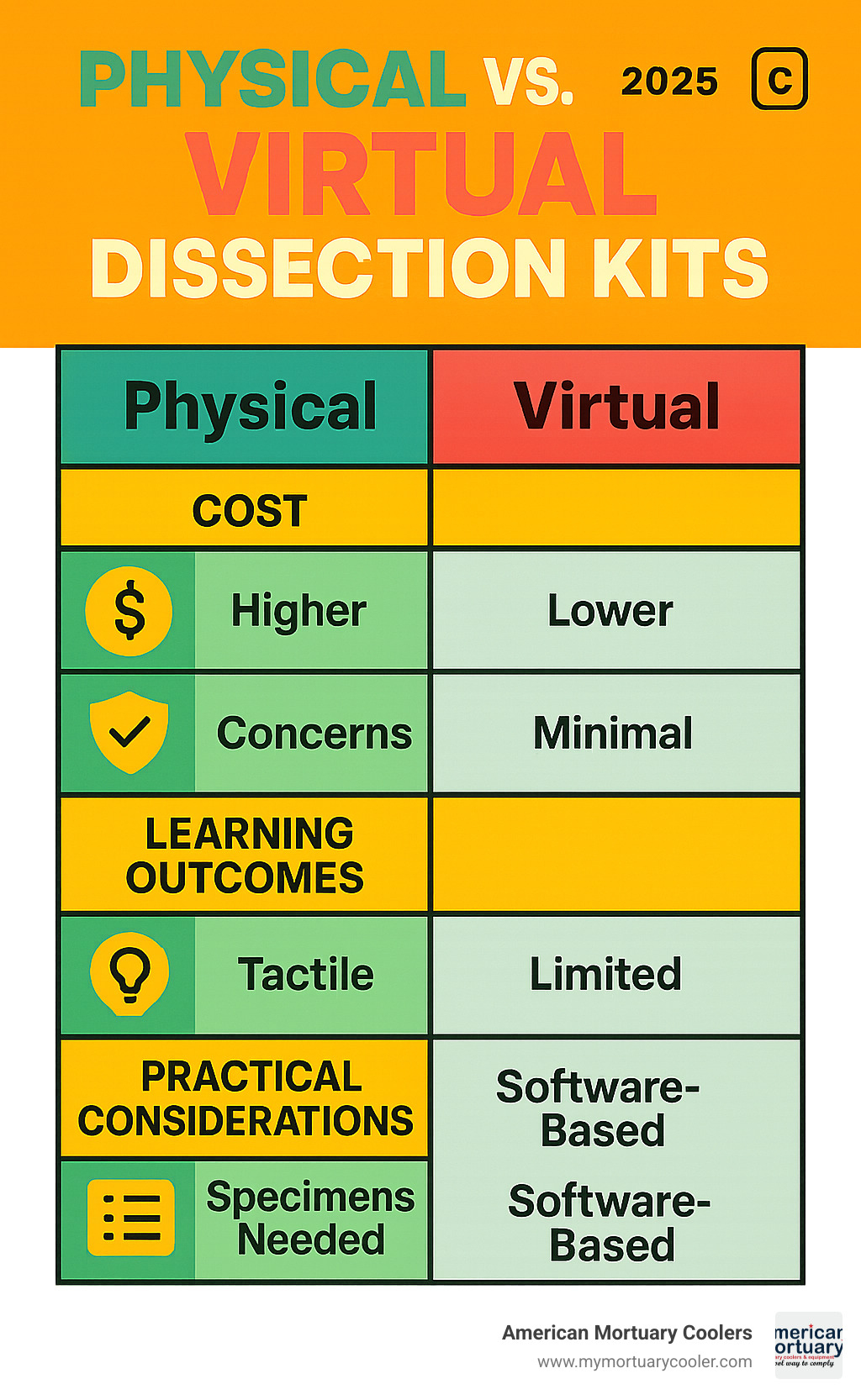
The most successful programs use a hybrid approach. Virtual tools work wonderfully for preparation and review, but nothing replaces the core learning experience of working with actual specimens.
Toolbox & Safety Protocols: From Scalpels to PPE
Think of safety as your best teaching assistant when it comes to kit dissection. Your safety foundation starts with personal protective equipment. Every single person in the room needs nitrile gloves, safety goggles, and lab aprons. No exceptions.
Ventilation might seem like overkill with today's odorless specimens, but proper air circulation still matters. Some specimens carry California Proposition 65 warnings because they contain traces of formaldehyde or methanol.
Sharps disposal requires dedicated containers. Never toss scalpel blades in regular trash. Used specimens are much simpler – just seal them in plastic bags for standard waste disposal.
First-aid preparation should include eye wash stations, basic bandages, and clear emergency procedures. Every kit dissection session needs qualified teacher supervision, regardless of student age.
Want to dive deeper into professional-grade tools? Check out Cutting Through Confusion: Dissection Tools and Equipment Explained for comprehensive equipment guidance.
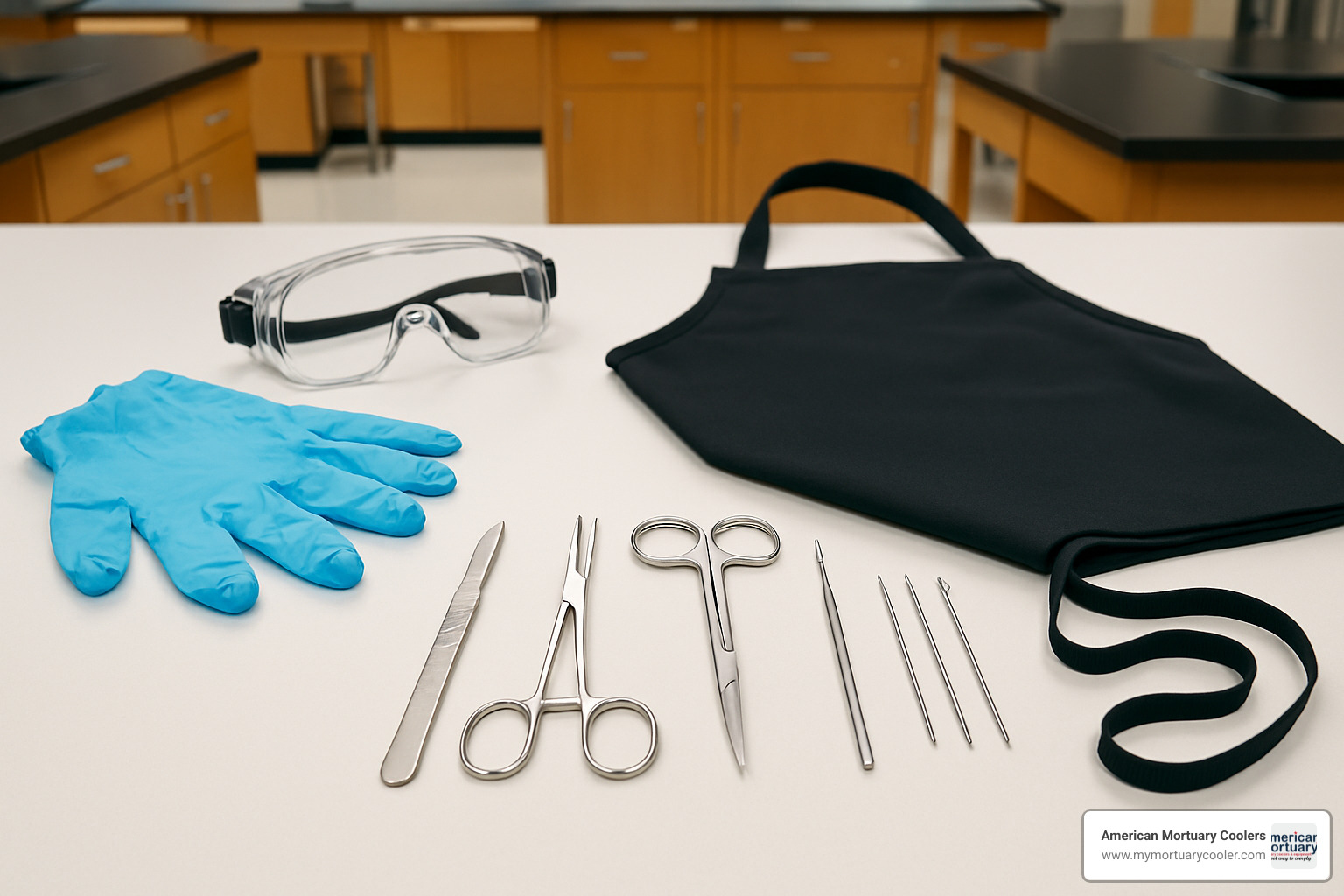
Know Your Instruments and Their Functions
Scalpel systems form the heart of any dissection kit. Number 3 handles pair with smaller blades for detailed work, while number 4 handles accommodate larger blades for initial cuts. Always cut away from your body and keep fingers clear of the blade path.
Forceps come in several varieties. Straight forceps at 4½ inches work perfectly for general grasping. Tissue forceps with their 1:2 teeth ratio grip specimens securely without causing damage. Adson forceps provide precision control for delicate structures, while Kelly forceps provide strength for tougher tissues.
Specialized tools include teasing needles in straight and angled versions for separating fine structures, dissecting scissors for tough materials, and grooved directors to guide cuts along specific paths.
For detailed insights into specific instruments, explore A Comprehensive Guide to Adison Forceps: Uses & Features.
Essential Safety Checklist Before You Cut
Before you begin, verify that all participants wear complete PPE. Inspect every tool for damage that could cause slipping. Clean and disinfect all work surfaces, then position labeled sharps disposal containers within easy reach.
During your dissection, maintain organized workspaces where tools have designated spots. Use each instrument only for its intended purpose. Keep fingers consistently clear of cutting paths, and create a culture where accidents get reported immediately.
Post-dissection cleanup requires cleaning tools with boiling water sterilization or approved sterilizers. Store specimens properly, disinfect work surfaces thoroughly, remove and dispose of PPE safely, and ensure everyone washes hands completely.
Step-By-Step Dissection Procedures & Ethical Considerations
When you're ready to begin your kit dissection journey, having a clear roadmap makes all the difference. Each specimen tells its own story, and understanding the proper techniques helps you open up those biological secrets while maintaining respect for the organisms you're studying.
Frog anatomy remains the gold standard for educational dissection, offering about 2 hours of hands-on findy. You'll start by examining the external features, then make that first careful incision to find the two-chambered heart system that's so different from our own four-chambered design.
Perch gills provide an amazing window into how fish breathe underwater. When you carefully lift that protective operculum, you're seeing one of nature's most efficient oxygen extraction systems.
Flower pistil dissections reveal the intricate world of plant reproduction in just 30 minutes. Splitting open a lily's pistil shows students the pathway pollen takes from stigma through style to reach the ovary.
For deeper insights into anatomical research methods, Scientific research on animal internal anatomy offers valuable perspectives on educational dissection techniques.
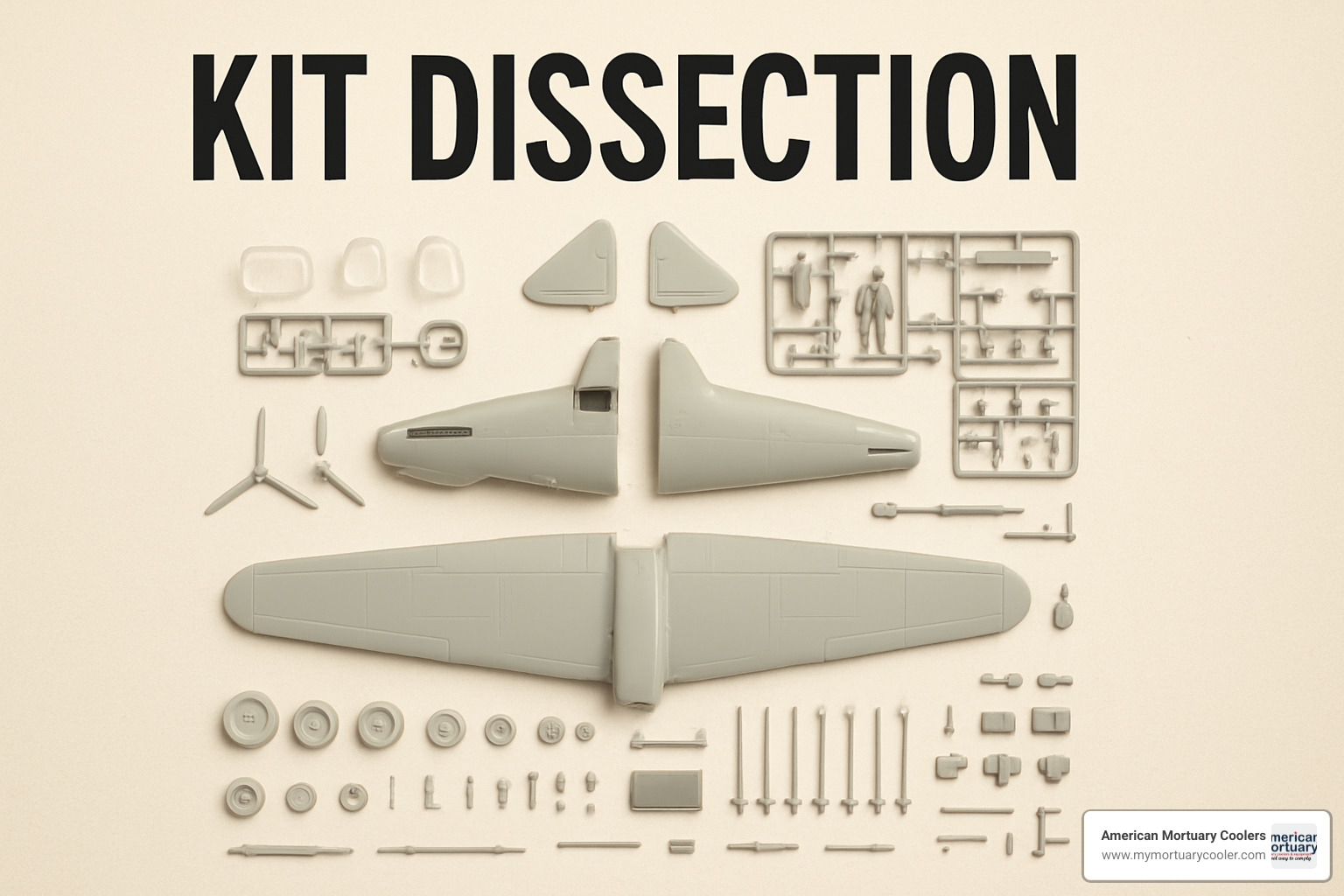
Classic Specimens: Quick Guides
Your frog 2-hour lab begins with counting those digits and noticing how the skin feels. Making that midventral incision from sternum to pelvis requires steady hands and patience. Once you pin back those skin flaps, the liver dominates the upper cavity, while the heart sits protected in its pericardial sac.
Perch worksheet activities start with orientation basics. Removing one operculum reveals those beautiful gill arches – usually four per side. The swim bladder often surprises students with its size and importance for buoyancy control.
Owl pellet bones offer a detective story in every specimen. Using plastic forceps and a magnifying lens, students uncover tiny skulls and bones that tell stories about predator-prey relationships.
Lily dissection transforms a simple flower into a lesson about plant reproduction. Removing sepals and petals systematically reveals the reproductive structures underneath. Splitting the pistil traces the pathway from stigma through style to ovary.
Ethical Sourcing, Preservation, and Disposal
Modern kit dissection has evolved significantly to address ethical concerns. Today's specimens come from suppliers who follow strict humane sourcing protocols and respect legal restrictions protecting certain species.
Formaldehyde-free preservation represents a major breakthrough for classroom safety. These vacuum-packed specimens arrive odorless, nontoxic, and fully preserved for six months in their sealed packaging.
Disposal bags make cleanup straightforward and environmentally responsible. Used specimens typically go into sealed plastic bags for regular waste disposal, though you should always check local regulations.
Classroom consent policies help steer the sensitive nature of dissection activities. Having virtual alternatives available ensures that every student can participate in learning while respecting individual beliefs and comfort levels.
Classroom & Homeschool Integration + Kit Maintenance
Bringing kit dissection into your learning environment doesn't have to feel overwhelming. The key is connecting these hands-on experiences to the bigger picture of biological learning.
Lesson plans work best when they sandwich the actual dissection between preparation and reflection. Start with virtual explorations and anatomical diagrams to build vocabulary. Then dive into the hands-on work. Finally, wrap up with discussions that help students process what they've finded.
Lab manuals become your best friend here. Quality manuals provide observation questions that spark critical thinking and offer assessment rubrics that help you measure learning outcomes.
For classroom teachers, group packs solve the budget puzzle while keeping everyone engaged. Those owl pellet investigations come in 30-student packs where teams can share tools while each student gets their own specimen to explore.
The beauty of quality kit dissection tools lies in their durability. Those stainless steel instruments can serve multiple classes across several academic years when properly maintained.
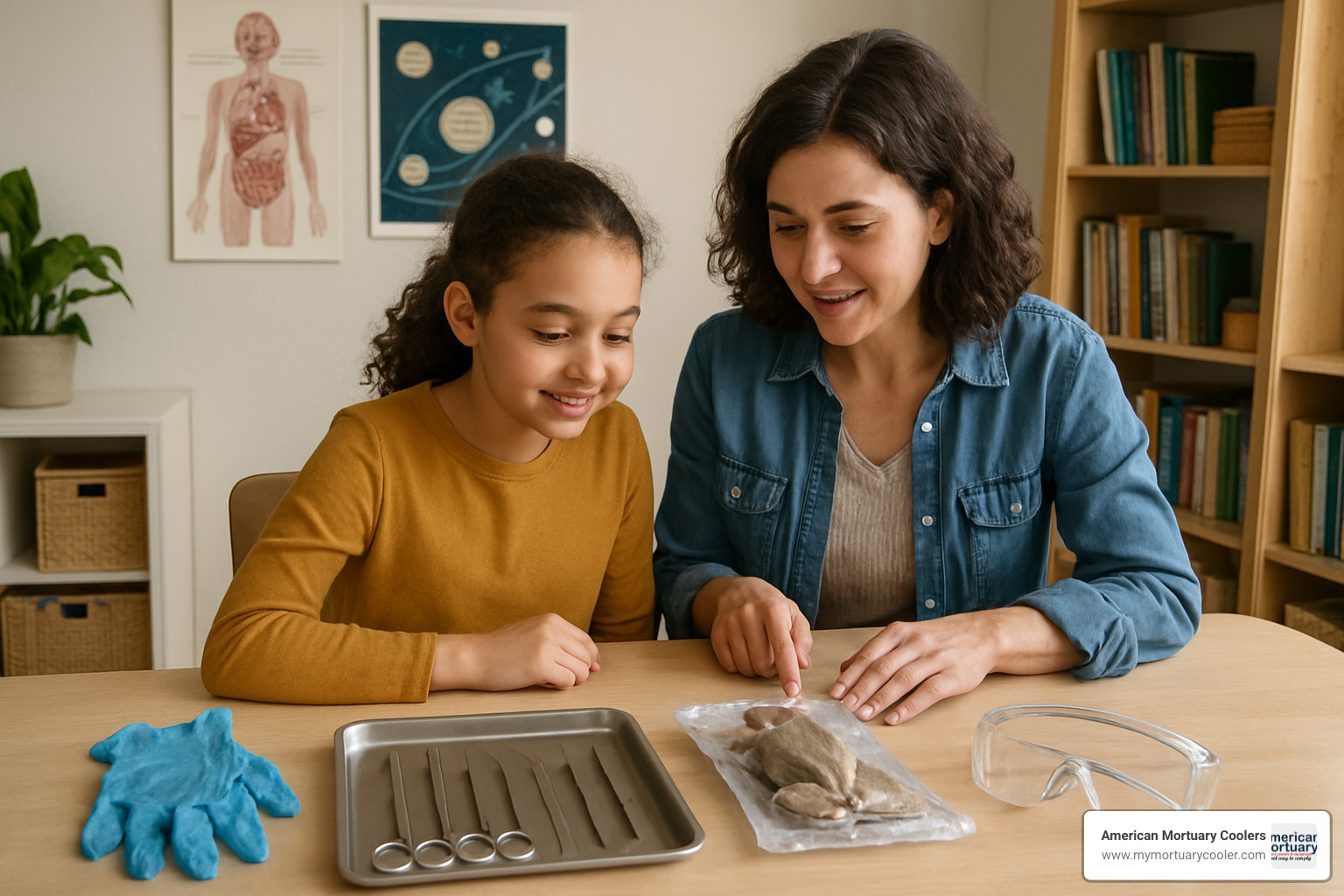
Reusing, Cleaning, and Storing Your Dissection Kit
Taking care of your dissection tools isn't complicated, but it does require attention to detail. Boiling water sterilization remains the gold standard for cleaning instruments after use. Clean everything immediately while organic material is still easy to remove.
Blade replacement becomes routine once you get the hang of it. Scalpel blades dull quickly with repeated use. Keep spare blades in your kit, but store them securely. Always dispose of used blades in designated sharps containers.
Case drying might seem obvious, but it's the step most people skip. Moisture trapped in storage cases creates the perfect environment for rust and corrosion. Open those cases wide and let everything air dry completely before packing up.
For long-term storage, treat your instruments like the precision tools they are. Cool, dry locations away from direct sunlight work best.
Supporting Materials and Digital Improvements
Modern kit dissection benefits enormously from digital support materials. Photo guides show students exactly what they should be seeing, building confidence and improving accuracy.
Video tutorials let students review procedures at their own pace. Virtual reality add-ons represent the cutting edge of preparation tools, allowing students to explore detailed 3D anatomical models before touching their first specimen.
Printable worksheets give you the flexibility to tailor activities to your specific curriculum standards. Include observation tables for data collection and critical thinking questions that push students beyond simple identification.
For educators interested in how these skills translate to professional applications, Autopsy Tables: In-Depth Analysis of Design and Functionality in Forensic Pathology offers insights into advanced anatomical work.
Frequently Asked Questions about Dissection Kits
Let's tackle the most common questions I hear from educators and parents about kit dissection. These come up repeatedly, so you're definitely not alone if you're wondering about these things!
What age is appropriate to start using a dissection kit?
Here's the honest answer: most kids are ready for basic kit dissection around age 11, but it really depends on the individual child more than their exact age. I've seen mature 10-year-olds handle dissection tools with incredible focus, while some high schoolers still struggle with the precision required.
Elementary students (ages 8-11) do wonderfully with flower dissections and owl pellet explorations. These activities introduce scientific observation without the complexity of animal anatomy. Plus, most kids find it fascinating to find tiny bones and skulls inside owl pellets!
Middle schoolers typically handle earthworms, crayfish, and even frog dissections quite well. Their fine motor skills have developed enough for careful tool use, and they're usually excited about the "gross factor" rather than squeamish.
High school and college students can tackle the more complex specimens like fetal pigs and human brain dissections. These advanced kit dissection experiences require steady hands and serious attention to detail.
The real key isn't age - it's maturity and the ability to follow safety protocols consistently. Trust your instincts about whether a child is ready for this responsibility.
Can I reuse preserved specimens after opening?
Absolutely! This is one of the best improvements in modern kit dissection - you're not stuck with single-use specimens anymore. Once you open a preserved specimen, just pop it into a sealed plastic bag, and it'll stay usable indefinitely. No fancy chemicals needed.
Vacuum-packed specimens are especially convenient. They stay fully preserved for six months in their original sealed package, which is perfect for planning multiple lab sessions or sharing between classes.
Some teachers prefer storing opened specimens in 35% alcohol solutions for extended periods, but honestly, that's overkill for typical classroom use. The sealed bag method works perfectly well and saves you the hassle of mixing chemicals.
Just remember to label your storage bags with the contents and date. Trust me, you'll thank yourself later when you're trying to figure out which bag contains the earthworms versus the crayfish!
What are the best alternatives if my school bans animal dissections?
Don't worry - you've got plenty of excellent options that still deliver meaningful hands-on learning experiences. Many schools are moving in this direction, and the alternatives have gotten really impressive.
Virtual dissection software has come a long way. These programs offer unlimited "specimens" for practice, incredible 3D detail, and interactive features you could never get with physical specimens. Students can explore digital frog anatomy, virtual pig dissections, and detailed brain models that rotate and zoom in ways real specimens can't.
Plant dissections remain welcome in almost every setting and teach fundamental biological concepts beautifully. Flower dissections demonstrate reproduction systems, while stem and root examinations show how plants transport nutrients. These kit dissection activities cost about 30 cents per lily and take around 30 minutes.
Owl pellet investigations occupy a unique middle ground. Since these are naturally occurring waste products, they're generally acceptable even in schools with strict animal policies. Students still get that detective work experience of finding tiny bones and reconstructing food chains.
Consider a hybrid approach - students might explore digital models first to build familiarity, then move to plant dissections or microscope work with prepared slides. This maintains the hands-on element while addressing ethical concerns effectively.
Conclusion
What started as a simple exploration of kit dissection tools has revealed the power of hands-on learning to transform how students understand life itself. From that first nervous moment holding a scalpel to the excitement of identifying a frog's beating heart, these experiences create memories that last a lifetime.
We've covered everything you need to know: choosing between basic 9-piece kits at $13.95 and comprehensive 23-piece professional sets, understanding quality stainless steel instruments, and creating safe learning environments where curiosity can flourish. The right kit dissection setup doesn't just teach anatomy – it builds confidence, develops critical thinking, and opens doors to scientific careers.
At American Mortuary Coolers, we've spent years understanding what makes laboratory equipment truly durable. While our Tennessee-based company specializes in custom mortuary coolers for the funeral industry, our expertise in precision equipment and reliable delivery across the contiguous 48 states extends naturally to supporting educational excellence.
The investment in proper dissection materials pays off in unexpected ways. Students who work with real specimens develop spatial reasoning that helps in engineering classes. The manual dexterity gained from careful dissection improves performance in art and technical courses. The scientific observation skills transfer to chemistry labs and physics experiments.
Whether you're setting up a traditional classroom, creating a homeschool lab, or upgrading an existing program, the principles remain the same. Quality instruments, proper safety protocols, age-appropriate specimens, and enthusiastic instruction create the foundation for meaningful learning.
The debate between virtual and physical dissection will continue, but the evidence is clear – nothing replaces the tactile experience of findy. When a student carefully separates tissue layers to reveal the intricate beauty of biological design, something profound happens. Abstract concepts become concrete understanding.
Ready to transform your biology program? Visit us at mymortuarycooler.com to explore how our commitment to durable, reliable equipment can support your educational goals. Our team understands the unique challenges of educational institutions and the importance of equipment that performs consistently year after year.
The future of biological education depends on maintaining these hands-on experiences. By choosing quality tools and following proven protocols, we ensure that students continue to experience the wonder of findy that only comes from exploring life's intricate designs with their own hands.
















